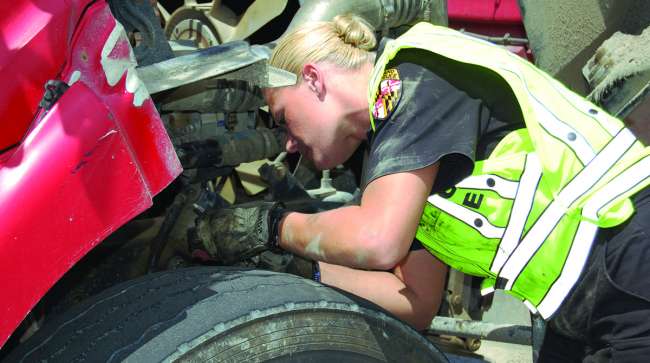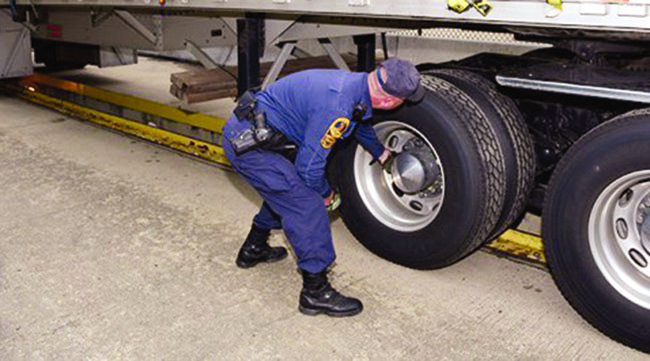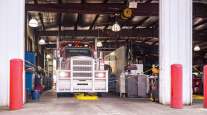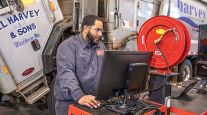Special to Transport Topics
Rigorous Maintenance Essential to Avoiding Brake Problems

Brakes remain the No. 1 culprit for out-of-service violations for Class 8 trucks, and preventive maintenance on the pneumatic system is vital to avoid violations and downtime, industry experts said.
“We will not operate with a leak,” said Joel Lalicker, senior director of maintenance at Pennsylvania-based PGT Trucking. “We want the brakes functioning at 100% [and] we do not take any risks in that space.”
Leaks happen on all brakes used on Class 8 vehicles.
“I wouldn’t tie it to any one supplier or type of brake, be it disc or drum,” Lalicker said.
Jack Legler, technical director at the Technology & Maintenance Council, part of American Trucking Associations, agreed.
“Air leaks do not care what type of brake is involved,” he said. “Any audible air leak is an out-of-service condition.”
Air drives everything because it’s a pneumatic system, Legler said. Leaks in a truck’s air system, therefore, present a big headache when they occur — and a major opportunity for preventive maintenance, he said.
Air system checks are an “obvious part” of preventive maintenance truck inspections, but these issues often become overlooked, Legler said.

An officer performs a brake inspection. (Commercial Vehicle Safety Alliance)
Out-of-service time caused by an air leak quickly can escalate to a costly endeavor, which is one reason fleets should ensure their PM program and their drivers are “up to speed” on what to listen and look for, what “right” looks like and when to report a problem, PGT’s Lalicker said.
Although the air system itself is relatively simple, finding a leak can be complicated and frustrating because they can occur anywhere along the line — service brakes, parking brakes, emergency brakes, air compressors, air storage tanks or control pedals — and they’re essentially an invisible problem.
“Air leaks are insidious because they’re tough to trace, particularly on long combination vehicles,” Legler said. “If you don’t maintain good air pressure all the way back to that farthest axle on the farthest trailer, you might end up with brake dragging that you may not realize,” which can lead to overheating or even a fire.
Typically, routing or chafing, among other issues, are the reasons why leaks develop, Lalicker said.
The most effective way to combat air leaks is to ward them off before they occur through rigorous PM routines. These include physically testing the air brake system, but also visually spotting line kinks, wear and potential damage to air system components.
Routine equipment inspections should include couplings, hoses, rubber seals and bearing lubrication levels.
When it comes to technology, telematics and data analytics can help by alerting fleet managers to specific areas where air leaks commonly occur on their trucks, allowing managers to “be more directive and targeted” in their PM programs, Lalicker said. “We absolutely use telematics,” he said.
With any type of trending data that can be extracted, “you’re going to figure out pretty quickly that you have some common areas where things are leaking,” he said, noting drivers should be instructed to frequently check those spots.
TMC also offers resources for air brake leak identification and maintenance and best practices for using telematics and predictive analytics during the problem-solving process.
Some maintenance experts turn to ultrasonic leak detectors to pinpoint air escaping the pressurized system if all else fails in finding a source. The handheld instruments use acoustic sensors to detect leak sounds in the ultrasonic frequency range, even in noisy trucking environments. The devices prove particularly useful on difficult-to-access areas of a truck.
Even with an easily detected audible air leak, continuing to inspect the entire system for additional, hidden leaks is crucial. “It’s the discipline and diligence of when you find one, you still keep looking and check the whole system and make sure it’s operating as designed,” Lalicker said.
Once leaks are identified, they’re usually not considered a difficult problem to repair. The most frequent fixes require replacing a hose, valve or diaphragm, although larger solutions such as storage tank replacement are necessary at times.
Maintenance professionals must be particularly mindful of using compatible components because even small fixes performed incorrectly or with incompatible parts can exacerbate an existing leak or create a new one.
In addition to improving safety, identifying and repairing air leaks boosts the pneumatic system’s efficiency, resulting in less fuel spent and lower operating costs.
“Put as much of your effort and time as possible upstream in the training protocols and pre-trip and post-trip inspections,” Lalicker said, noting that ultimately, “a driver down is costly to the organization, our customers and the driver.”




